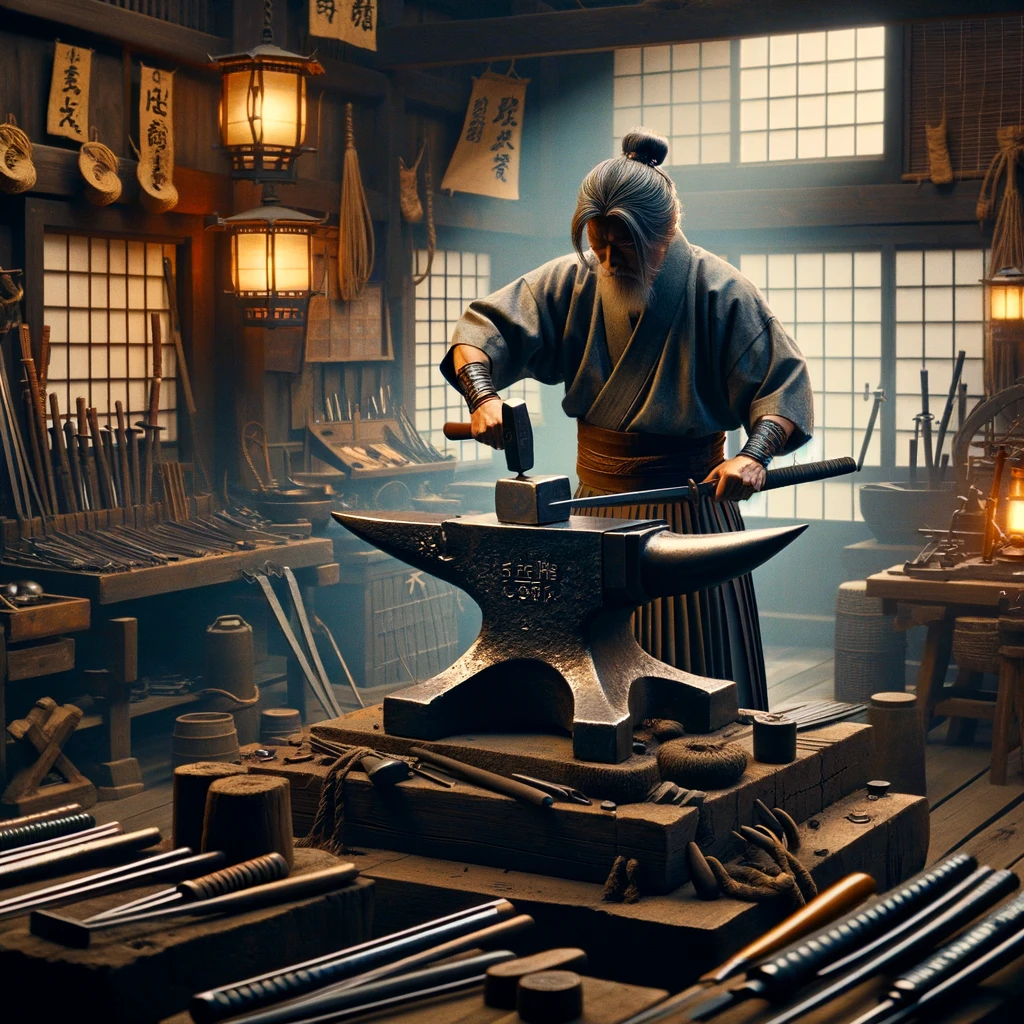Crafting a samurai katana sword requires precision, patience, and the right tools. This ancient art has been passed down through generations, with each craftsman adding his touch. The tools and equipment used play a vital role in ensuring the katana sword‘s quality. In this article, we will explore the essential tools and equipment used in crafting a samurai katana sword. Let’s dive into the details.

I. The Forge: The Heart of Sword Crafting
The forge is where it all begins. It is the heart of the sword-making process. Here, the raw steel is heated until it becomes malleable. Traditional forges use charcoal as fuel. This provides the intense heat required. Modern forges, however, may use gas or electricity. Despite the differences in fuel, the goal remains the same. The forge must reach temperatures high enough to soften the steel. This step is crucial for shaping the samurai katana sword.
II. The Anvil: Shaping the Steel
Once the steel is heated, it is placed on the anvil. The anvil provides a solid surface for hammering. Swordsmiths use heavy hammers to shape the steel. Each strike is deliberate and precise. The anvil’s flat surface ensures even shaping. Over time, the steel begins to take the form of a blade. The swordsmith must carefully monitor the process. Any mistake at this stage could ruin the sword.
III. Hammers: The Craftman’s Extension
Hammers are essential tools in the sword-making process. They come in various sizes and weights. Each hammer serves a specific purpose. The heavier hammers are used for initial shaping. They help flatten the steel quickly. Lighter hammers are used for finer details. They allow for more control and precision. The choice of hammer depends on the stage of crafting. Transitioning between hammers is common as the sword takes shape.
IV. The Quenching Tank: Setting the Blade’s Hardness
After shaping, the blade must be hardened. This is done in the quenching tank. The blade is heated again and then rapidly cooled. This process, known as quenching, sets the blade’s hardness. Traditional quenching tanks contain water or oil. The choice of liquid affects the blade’s final properties. Water quenching results in a harder blade. Oil quenching, however, provides a balance between hardness and flexibility. The swordsmith must carefully control the cooling rate. Too fast, and the blade may crack. Too slow, and it may remain too soft.
V. Whetstones: Sharpening the Blade
Once hardened, the blade must be sharpened. Whetstones are used for this purpose. These stones come in various grits. Coarser grits are used first to remove material quickly. Finer grits are used to refine the edge. The swordsmith moves the blade across the stone at a consistent angle. This ensures a sharp and even edge. Whetstones are an essential tool in achieving the samurai katana sword’s legendary sharpness.
VI. Polishing Stones: Bringing the Blade to Life
After sharpening, the blade is polished. Polishing stones are used to achieve a mirror-like finish. The polishing process is meticulous. It requires skill and patience. The swordsmith must polish every inch of the blade. This step enhances the blade’s appearance and protects it from rust. The reflection on a polished blade is a sign of quality craftsmanship. Polishing also highlights the blade’s natural beauty. The swordsmith’s goal is to bring out the steel’s unique patterns.
VII. The Habaki: Securing the Blade
The habaki is a small but vital piece of equipment. It is a metal collar that fits around the base of the blade. The habaki secures the blade in the scabbard. It also ensures a snug fit, preventing the blade from rattling. The habaki must be precisely made. If it is too loose, the blade may slip. If too tight, it may damage the scabbard. Crafting the habaki requires precision and attention to detail.
VIII. The Scabbard: Protecting the Samurai Katana Sword
The scabbard, or saya, protects the samurai katana sword when not in use. It is usually made from wood, carefully carved to fit the blade. The inside is lined with a soft material to prevent scratches. The outside may be decorated with lacquer or other materials. The scabbard must fit the blade perfectly. A well-crafted scabbard is both functional and beautiful. It reflects the care and craftsmanship put into the entire sword.

IX. Conclusion
In conclusion, the tools and equipment used in crafting a samurai katana sword are essential to its quality. From the forge to the final inspection, each tool plays a vital role. The samurai katana sword is more than just a weapon. It is a work of art, crafted with precision and care. The tools of the trade are an extension of the swordsmith’s skill. Without them, the art of katana making would not be possible. Through these tools, the legacy of the samurai katana sword continues to thrive.